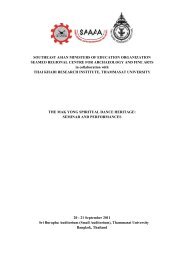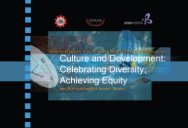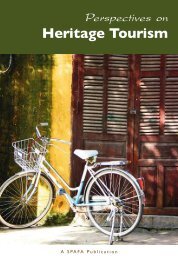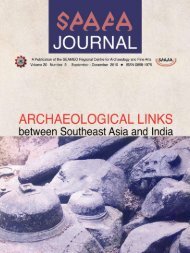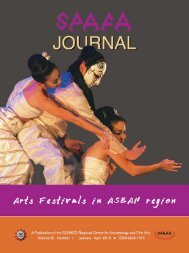Untitled - Telling Tales from Southeast Asia and Korea - APCEIU
Untitled - Telling Tales from Southeast Asia and Korea - APCEIU
Untitled - Telling Tales from Southeast Asia and Korea - APCEIU
- No tags were found...
Create successful ePaper yourself
Turn your PDF publications into a flip-book with our unique Google optimized e-Paper software.
SEAMEO-<strong>APCEIU</strong>SEAMEO-<strong>APCEIU</strong>SESSION 2The country presenters comprised Mrs. Kongdeuane Nettavong (Lao PDR), Mrs.Faziah binti Sulaiman (Malaysia), <strong>and</strong> Mr. U Nyunt Han (Myanmar).SUMMARY OF THE OPEN FORUMAs many folktales cut across cultures <strong>and</strong> countries, education officials must lookinto publishing the stories that can be considered truly unique <strong>and</strong> indigenous to theirrespective countries. Once compiled into books, these collections of regional folktalescan become an effective learning resource on the cultural diversity of <strong>Southeast</strong><strong>Asia</strong> <strong>and</strong> <strong>Korea</strong>.While younger learners can revisit old folktales in the learning resource that will bepublished, they will also be introduced to less popular stories that have not beenpreviously documented in primary-school textbooks.There exist bodies of local literature such as folktales that have been circulatingamong indigenous groups that need to be explored <strong>and</strong> brought into the mainstream.While it is not always easy to identify which stories are indigenous to certain communities,many were obviously unique to a country, particularly the legends of somel<strong>and</strong>marks <strong>and</strong> specific places.It was suggested that the stories be integrated into other school subjects such asmath, biology, <strong>and</strong> civics <strong>and</strong> that these be made more relevant to the younger generation.SESSION 3The country presenters comprised Ms. Fe M. Villalino (Philippines), Ms. RosemarieSomaiah (Singapore), <strong>and</strong> Ms. Jeon Eun Jeong (<strong>Korea</strong>).SUMMARY OF THE OPEN FORUMTeachers must be able to make the folktales applicable to the local environment <strong>and</strong>to the personal experiences of the schoolchildren. They must be encouraged to exercisetheir creativity in adapting folktales to local situations <strong>and</strong> contexts.SESSION 4The country presenters comprised Mr. Afonso Soares (Timor-Leste), Ms Nguyen ThiBich Lieu (Vietnam), <strong>and</strong> Dr. Prasong Saihong (Thail<strong>and</strong>).SUMMARY OF THE OPEN FORUMThe many parallels found in the foktales’ storylines was an indication of the universalityof certain human values. Likewise, the geographical proximity of the countriesin the region made these similarities inevitable.RESEARCH METHODS AND PROCESSESAs part of the Situation Analysis of Folktales in <strong>Southeast</strong> <strong>Asia</strong>, the survey was conductedin the 11 SEAMEO member countries <strong>and</strong> <strong>Korea</strong>. As stated earlier, the surveychiefly aimed to investigate the use of folktales in <strong>Asia</strong>n primary classrooms. Initiallydrafted by <strong>APCEIU</strong>, the questions were finalized through consultations amongpartner institutes. National researchers who were designated by the <strong>APCEIU</strong> <strong>and</strong>SEAMEO carried out the survey using questionnaires <strong>and</strong> presented the highlightsof the survey results during the regional meeting.The pool of national researchers―mainly composed of folktale experts <strong>and</strong> educationofficers―managed the distribution of the survey questionnaires. The nationalresearchers drew up a list of respondents according to the categories <strong>and</strong> numbersprescribed in the guidelines <strong>and</strong> distributed <strong>and</strong> collected the questionnaires to <strong>and</strong><strong>from</strong> the respondents. They subsequently checked the accuracy of data prior tosubmission to the SEAMEO Secretariat. <strong>APCEIU</strong> then proceeded to forward thecompleted questionnaires to SEAMEO INNOTECH, which was tasked to analyzethe data <strong>and</strong> to write an analysis based on the findings.The sampling procedure, which identified the survey respondents, adopted a purposiverather than a r<strong>and</strong>om sampling methodology. A sample size of approximately10 respondents was used in participating countries. Through purposive sampling,the survey targeted teachers of folktales, leading scholars in related institutes (e.g.,teachers <strong>and</strong> heads of language departments), <strong>and</strong> headmasters in primary <strong>and</strong>secondary schools who engage in teaching folktales.The survey was conducted in three stages, namely:Stage 1 : This stage involved the selection of national coordinators <strong>and</strong> thepreparation of survey tools <strong>and</strong> instruments. The SEAMEO Secretariat selectedresearchers <strong>and</strong> folktale experts who were capable of gathering dataon folktales in each country. The SEAMEO Secretariat identified these expertswith the help of partner institutes such as SEAMEO INNOTECH <strong>and</strong>SEAMEO SPAFA.Stage 2 : The national experts distributed the survey tools to at least 10 educationalinstitutions. They were further tasked to come up with a short list offive popular folktales <strong>and</strong> two outst<strong>and</strong>ing stories for publication. These folktaleswere presented in the regional meeting held in Thail<strong>and</strong>.67



